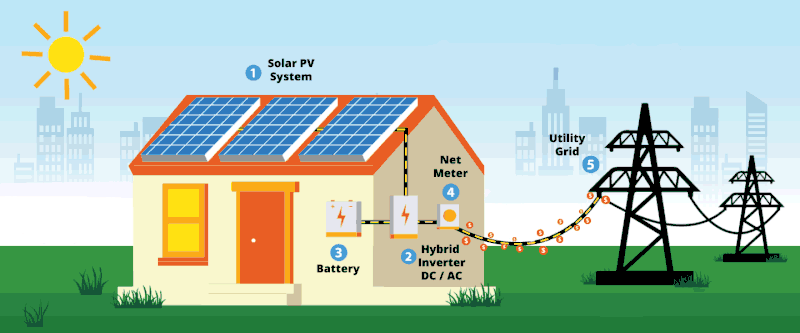

Solar panels absorb and transform sunlight into direct current (DC) electricity, with higher panel wattage leading to increased production.
The inverter converts the direct current (DC) electricity into alternating current (AC) electricity, which powers your home.
Batteries serve as storage or backup power. They store surplus energy generated by solar panels, which can be utilized during periods of low production, such as nighttime.
Your intelligent meter gauges both your energy production and consumption. Excess power generated by your system is credited to the grid by your smart meter when it surpasses your current needs.
After sunset, you draw on the accumulated excess power credits from the grid. Our goal is to size your solar system to generate 100% or more of your power usage.

Choosing Auralink for your solar transition comes with the benefit of zero out-of-pocket expenses and no upfront payment required. Unlike the past, when going solar was associated with high costs, the year 2023 marks a significant shift, eliminating any out-of-pocket or upfront expenses associated with the solar process. This means you can seamlessly embrace solar energy without the financial burden of initial payments.
Our solar systems are specifically engineered to completely offset 100% of your electricity consumption, ensuring that all your power comes from solar energy and resulting in the elimination of your electric bill. On average, you can anticipate savings ranging from 30% to 50%, or potentially experience no electric bill at all, depending on the specific solar option you choose.
In the event that you decide to move or sell your home, the convenience of our solar payment transferability ensures a seamless transition to the new owner. In the case of system ownership, the added benefit arises as the price of the solar system can be factored into the resale value of the home, contributing to its overall market worth. This not only facilitates the ease of transferring solar payments but also enhances the property’s appeal and value in the real estate market.
The Solar Investment Tax Credit (ITC) is a federal tax credit of 30% available for residential, commercial, and utility-scale solar systems that are installed before 01/01/2030. This credit directly reduces the income taxes of the customer who claims the ITC, providing a dollar-for-dollar reduction equal to 30% of the net cost of the solar system.
Net Metering allows homeowners producing their own electricity to feed any surplus back into the utility’s power grid. Any electricity not utilized by the home and returned to the grid is credited at a retail rate of 1-1. Essentially, the utility acts as a built-in battery for the solar system.
The power generated by your solar system is directly linked to the sunlight it receives. On cloudy days, it produces slightly less than on sunny days. However, our solar systems are optimized to maximize production even with minimal sunlight, especially on cloudy and rainy days. Solar panels don’t generate energy at night, but they overproduce during peak hours to supply power for your home during the night. Our team of specialized solar engineers employs a sophisticated tool that analyzes 50 years of weather data to project the energy output of each solar system over a specific timeframe.
If your system doesn’t include battery storage for complete independence from the utility company, you will continue to receive an electric bill. Despite this, our solar systems are crafted to eliminate 100% of energy consumption from the utility, resulting in a $0 electricity bill. The bill you receive from the grid is a connection fee, ranging from $12 to $15, for maintaining your connection to the utility company.
Grid-connected solar systems will automatically turn off during a utility power outage. This precautionary measure ensures that solar systems connected to the grid don’t send electricity back, preventing any potential danger to utility workers attempting to restore power during the outage.
Research from Lawrence Berkeley National Laboratory and Zillow indicates that owning a solar system can increase your home’s value by tens of thousands of dollars, adding up to 8% in resale value. Homes with solar panel installations are often perceived as more energy-efficient and environmentally friendly, making them appealing to potential buyers. Additionally, the potential for reduced energy costs and, in some cases, the opportunity to sell excess energy back to the grid can contribute to the overall attractiveness of a solar-powered home, positively impacting its market value.
At Auralink Solar, we provide you with compelling options that enable you to embrace solar energy without the need for incurring any debt. Our zero-debt alternatives empower customers to experience the advantages of solar without the financial burden of debt or the need for traditional financing. These debt-free choices are designed to make the transition to solar both accessible and financially stress-free, ensuring that you can enjoy the benefits of sustainable energy without compromising your financial well-being.
Auralink provides a comprehensive warranty package to ensure the longevity and performance of your solar system. With our commitment to quality, we offer a 25-year workmanship warranty, assuring you of the durability and craftsmanship of our installation. Additionally, we provide a 10-year roof penetration warranty, giving you peace of mind regarding any potential issues related to the penetration points on your roof. Our extended warranty coverage reflects our confidence in the reliability of our solar solutions, reinforcing our dedication to customer satisfaction and the long-term success of your solar investment.